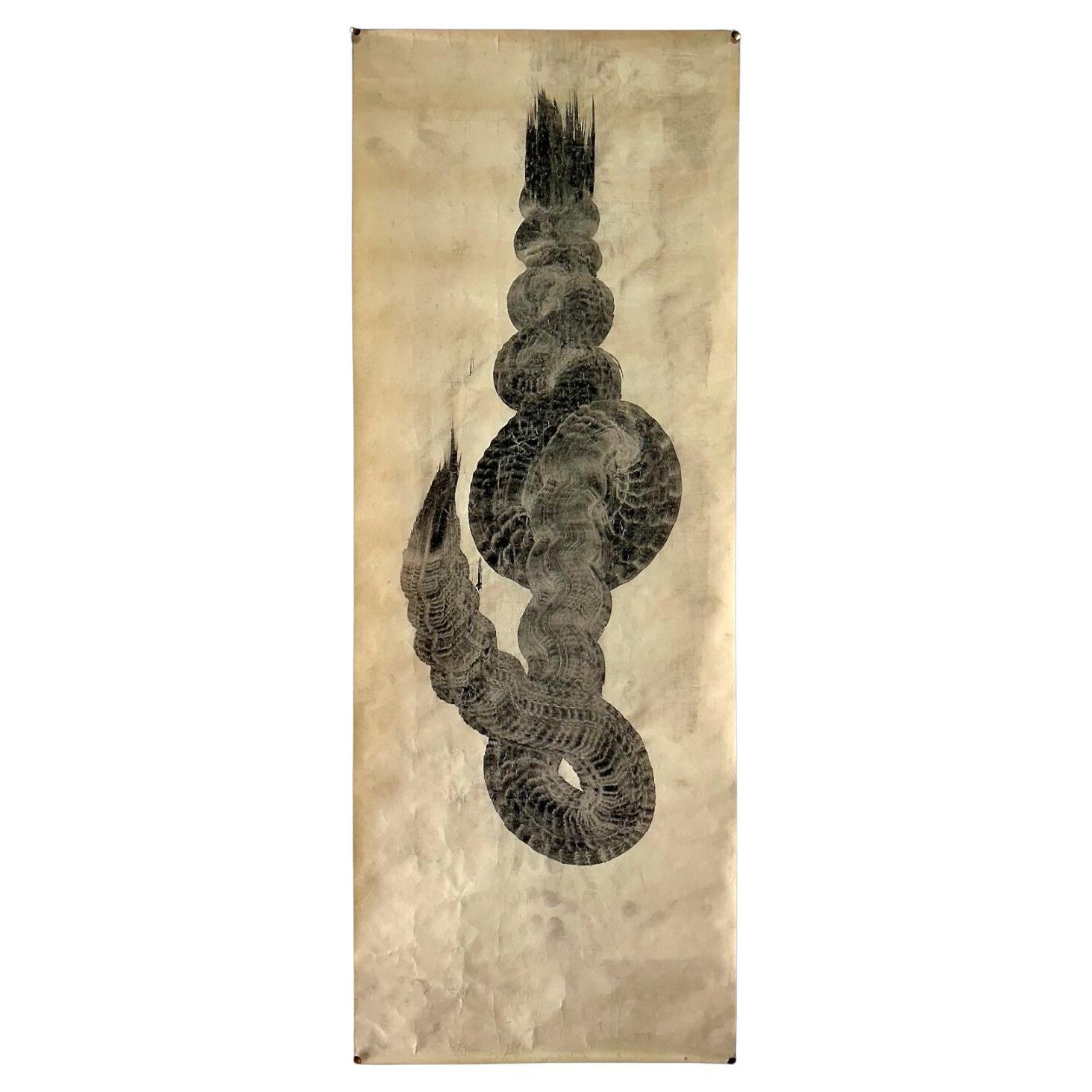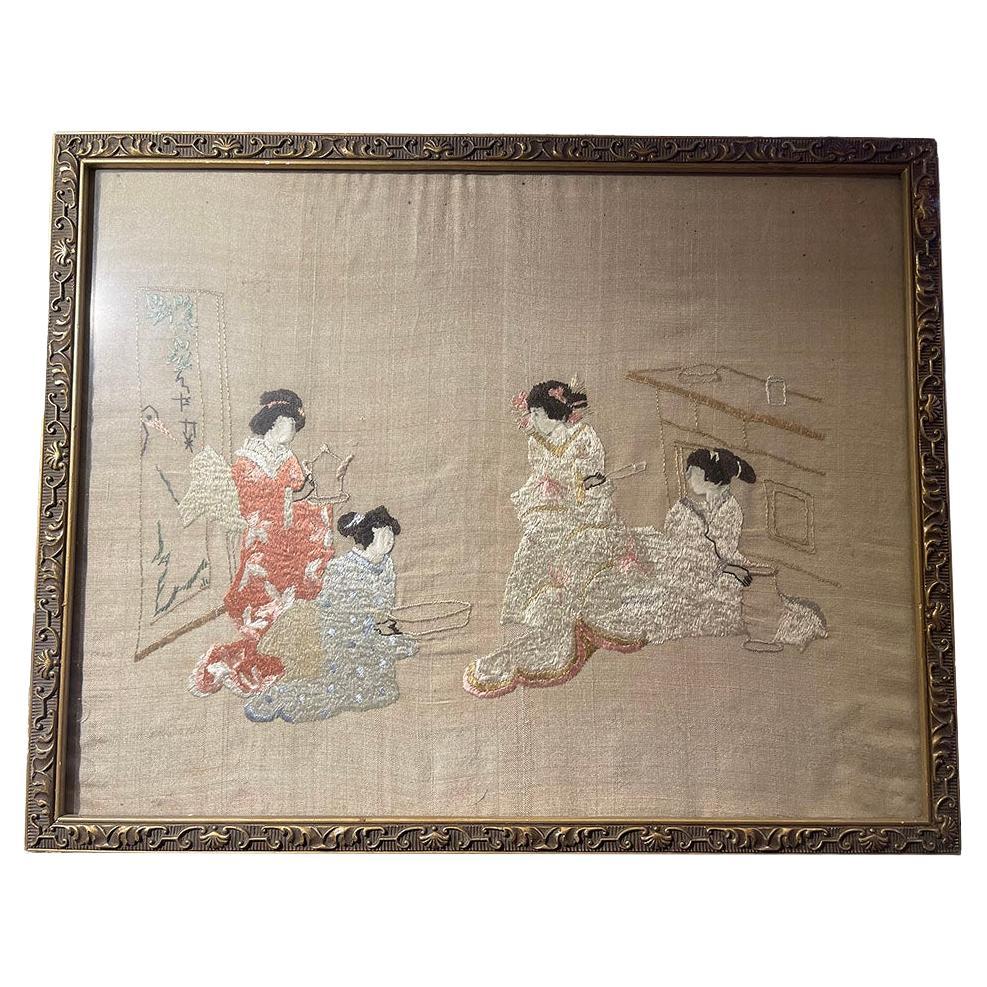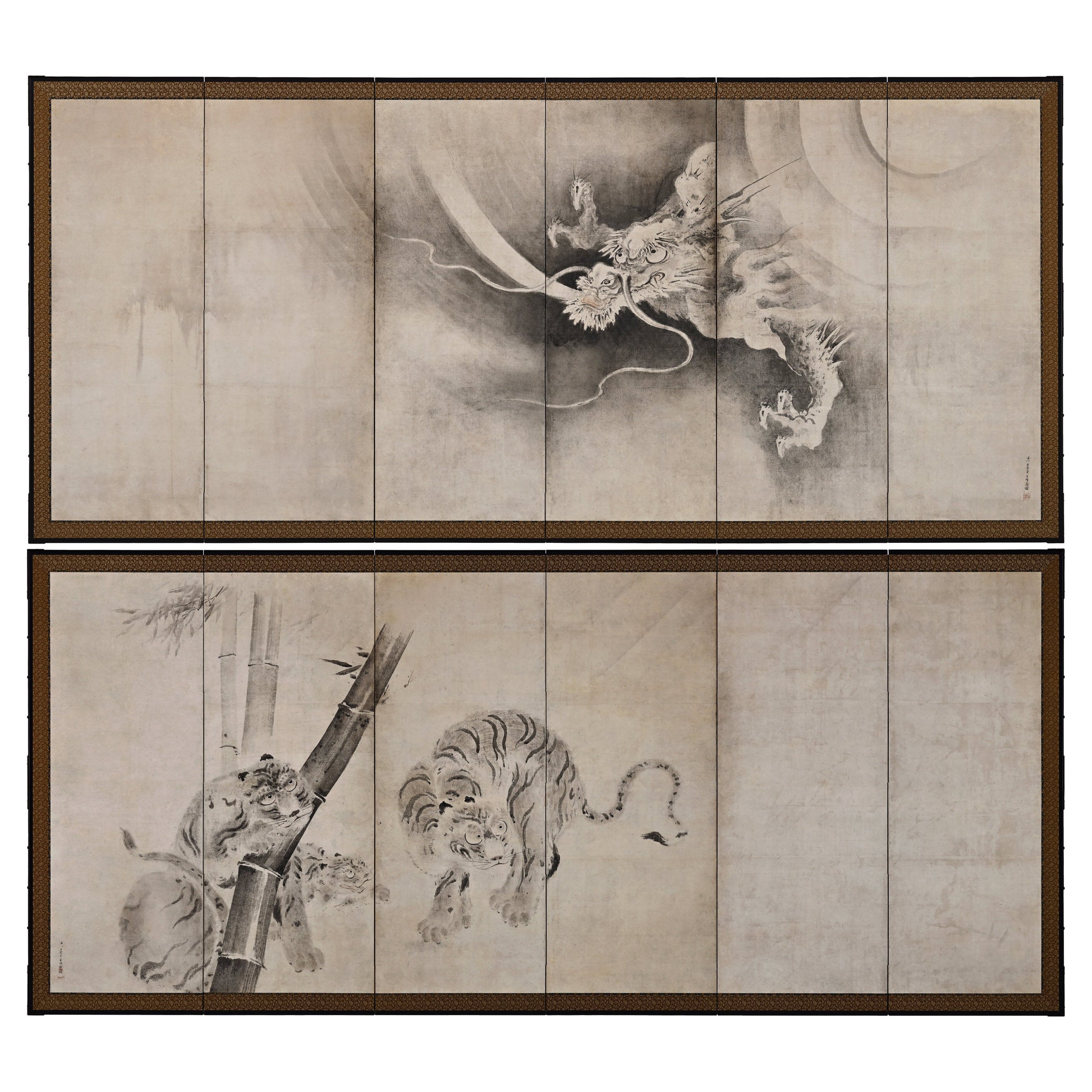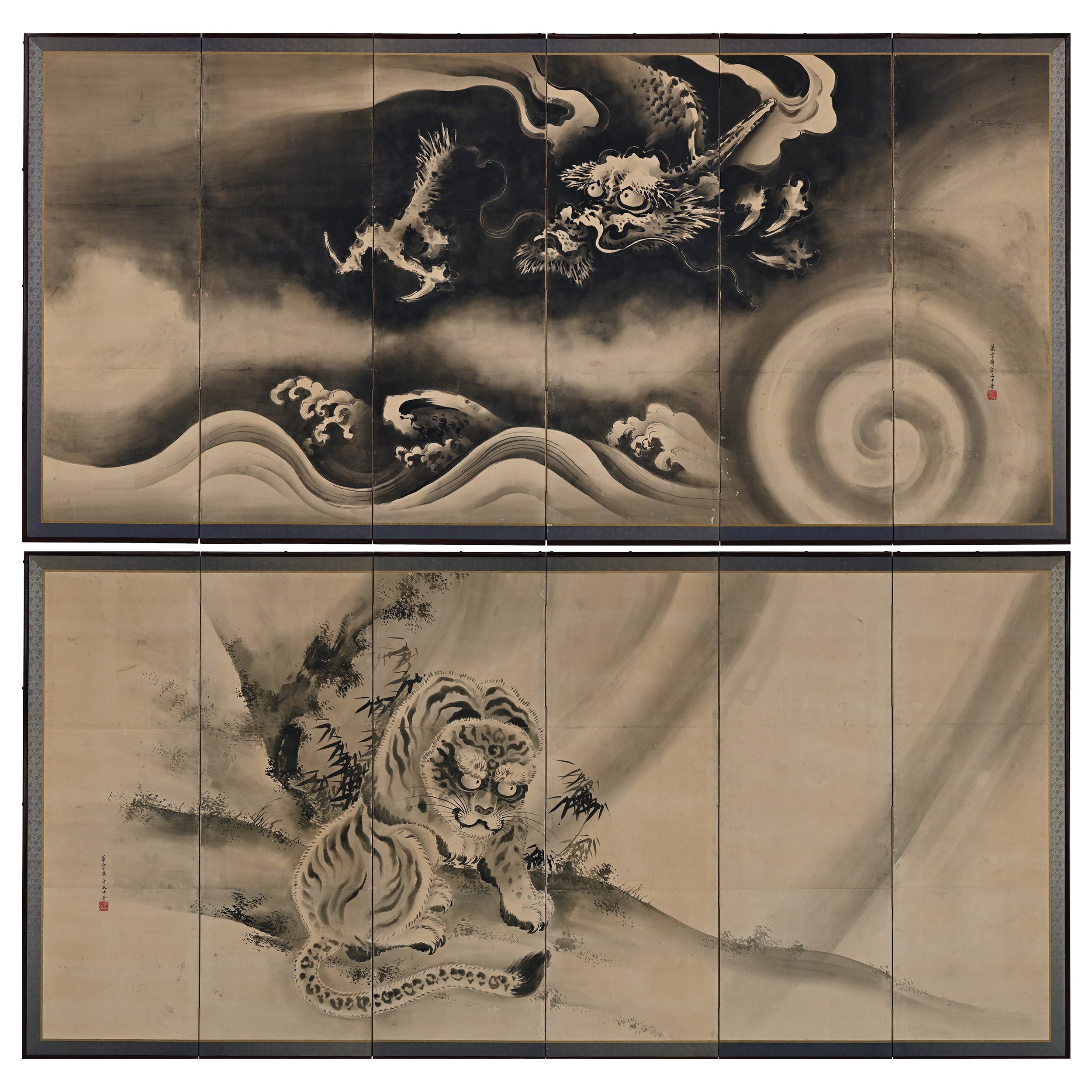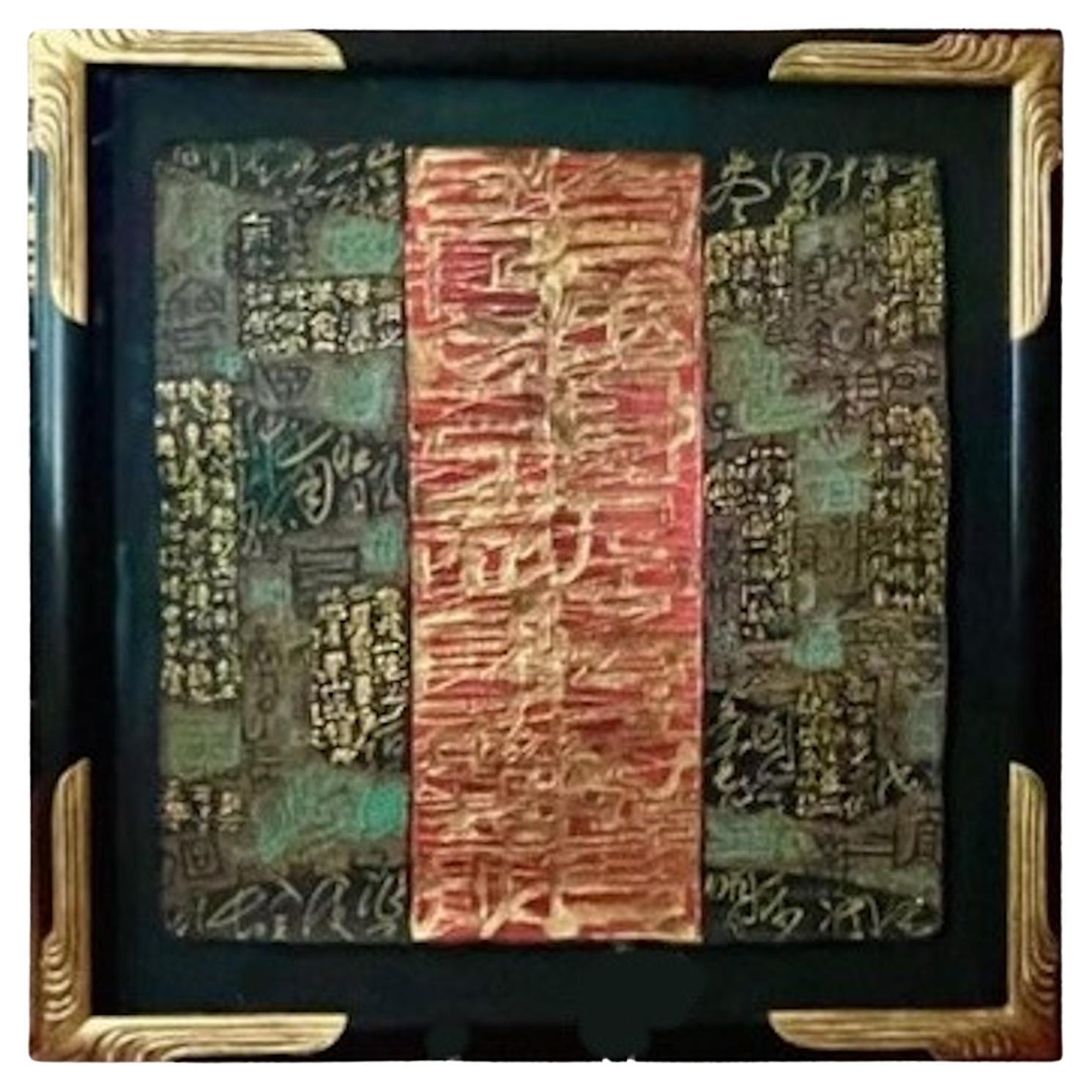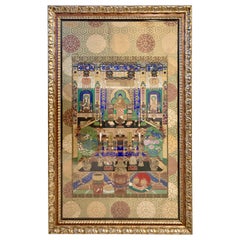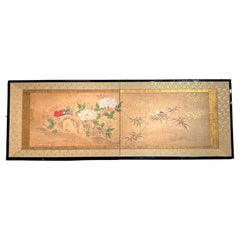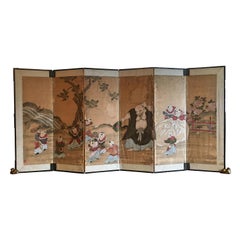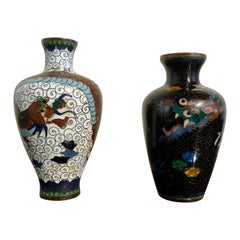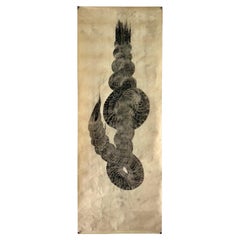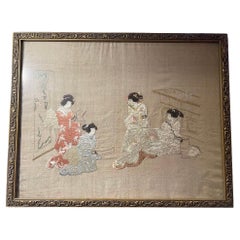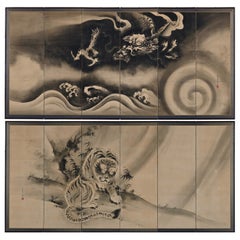Items Similar to Pair Large Framed Japanese Calligraphy "Dragon" & "Tiger", Mid 20th Century
Want more images or videos?
Request additional images or videos from the seller
1 of 8
Pair Large Framed Japanese Calligraphy "Dragon" & "Tiger", Mid 20th Century
About the Item
A large and powerful pair of Japanese calligraphic works, mid 20th century, Japan. One reading "Dragon", the other reading "Tiger". Ink on handmade paper, framed.
The brush strokes bold and brash, using the force the painter to move the ink around the wonderfully thick and textured handmade paper. The energy of the calligrapher is evident in each stroke and splash of ink.
Taken together, the paintings are about balance, capturing the essence of "inyo" (yin and yang). In Japanese culture, the tiger represents the earth and feminine energy, "in", while the dragon represents the heavens and the masculine energy, "yo".
The artist has captured both energies perfectly. The tiger expresses the feminine energy through graceful curves and undulations. Even more impressive is that this appears to be a single stroke painting, meaning the painting was completed in one continuous motion, without the brush leaving the paper.The dragon expresses the masculine energy through bold and aggressive strokes, with the ink splattering in dramatic ways across the painting.
The paintings mounted floating within a black framed shadowbox with natural linen background and acrylic front. Each with two hooks for hanging on the back.
Provenance:
Christie's, NY
Michael Smith's Palladian Villa.
- Dimensions:Height: 62.25 in (158.12 cm)Width: 37.25 in (94.62 cm)Depth: 2 in (5.08 cm)
- Sold As:Set of 2
- Style:Expressionist (Of the Period)
- Materials and Techniques:
- Place of Origin:
- Period:
- Date of Manufacture:Mid-20th Century
- Condition:Wear consistent with age and use. Minor scratching to the sides of the frames.
- Seller Location:Austin, TX
- Reference Number:1stDibs: LU894721024112
About the Seller
5.0
Vetted Professional Seller
Every seller passes strict standards for authenticity and reliability
Established in 2001
1stDibs seller since 2010
340 sales on 1stDibs
Typical response time: 1 hour
- ShippingRetrieving quote...Shipping from: Austin, TX
- Return Policy
Authenticity Guarantee
In the unlikely event there’s an issue with an item’s authenticity, contact us within 1 year for a full refund. DetailsMoney-Back Guarantee
If your item is not as described, is damaged in transit, or does not arrive, contact us within 7 days for a full refund. Details24-Hour Cancellation
You have a 24-hour grace period in which to reconsider your purchase, with no questions asked.Vetted Professional Sellers
Our world-class sellers must adhere to strict standards for service and quality, maintaining the integrity of our listings.Price-Match Guarantee
If you find that a seller listed the same item for a lower price elsewhere, we’ll match it.Trusted Global Delivery
Our best-in-class carrier network provides specialized shipping options worldwide, including custom delivery.More From This Seller
View AllLarge Framed Japanese Buddhist Amida Temple Hall Painting, Mid-19th Century
Located in Austin, TX
A large and incredible Japanese painting of a Buddhist temple hall with Amida Nyorai, late Edo or early Meiji period, mid-19th century, Japan. Mounted wit...
Category
Antique Mid-19th Century Japanese Meiji Paintings and Screens
Materials
Wood, Paint, Brocade, Silk, Acrylic
Japanese "Magpie and Peony" Two Panel Screen, Edo Period, 18th/19th century
Located in Austin, TX
A sublime Japanese two panel "Magpie and Peony" screen, ink and color on paper, Edo Period, late 18th or early 19th century, circa 1800, Japan.
The two panel screen features a wond...
Category
Antique Early 19th Century Japanese Edo Paintings and Screens
Materials
Copper
Japanese Six Panel Screen with Hotei, Edo Period, Early 19th Century
Located in Austin, TX
A delightful Japanese six panel painted paper screen featuring the beloved figure Hotei, Edo Period, early 19th century.
Hotei, called Budai in China, and known as the Laughing Buddha or Fat Buddha in the West, is considered to be an emanation of Maitreya, the Buddha of the Future.
In Japan, he also holds a special place as one of the Seven Lucky Gods, being the god of fortune, and protector of children.
He is always portrayed as a mirthful and corpulent man, dressed in loose robes that show off his round belly. He carries a sack with him, said to be filled with treasure. As the protector of children, he is often portrayed with them playing on or around him, as he is here. The children portrayed in this screen are dressed in Chinese style clothing...
Category
Antique Early 19th Century Japanese Edo Paintings and Screens
Materials
Silk, Paper
Two Small Japanese Cloisonne Dragon Vases, Early 20th Century, Japan
Located in Austin, TX
Two charming, small Japanese cloisonné dragon vases, Meiji to Taisho period, early 20th century, Japan.
The miniature vases of baluster f...
Category
Early 20th Century Japanese Taisho Metalwork
Materials
Copper, Enamel, Foil
Large Japanese Satsuma Covered Vase, Showa Period, Mid 20th Century, Japan
Located in Austin, TX
A very large and exuberantly decorated Japanese Satsuma millefleur covered vase, marked Satsuma, Showa period, mid 20th century, Japan.
The large vase of attractive baluster form, with a slightly splayed foot, narrow waist, and tapered body with high shoulders and short neck. The vase topped by a domed cover with a large finial shaped like a hoju, the wish fulfilling jewel.
The vase decorated all over in a dense field of flowering blossoms - peony, lotus, and chrysanthemum - in a design known as millefleur, or a thousand flowers. The flowers freely and cheerfully painted in various colors of red, white, orange, green, blue and yellow, with raised white enamels...
Category
Mid-20th Century Japanese Showa Ceramics
Materials
Stoneware
Ceramic Mythical Beast Wall Plaque by Jim Meredith Studios, Late 20th Century
Located in Austin, TX
A wonderful cast ceramic wall plaque of a mythical Celtic beast, by Jim Meredith Studios, late 20th century.
The plaque, imitating ancient carved stone...
Category
Vintage 1980s American Archaistic Wall-mounted Sculptures
Materials
Ceramic
You May Also Like
One stroke calligraphy painting of Dragon . 20th century Zen calligraphy
Located in Fukuoka, JP
Stunning one stroke Zen calligraphy painting depicting Dragon. Ink on paper. Sold as it is , please refer to the photos.
Age:20th century
Size: 106.5/40 cm (41.9/15....
Category
20th Century Japanese Showa Paintings and Screens
Materials
Paper
Mid-20th Century Japanese silk embroidered framed painting
Located in Delft, NL
Mid-20th Century Japanese silk embroidered framed painting
A silk embroidered painting and is framed behind glass with a scene of women in a room with a stork in the doorway in the ...
Category
Mid-20th Century Japanese Paintings and Screens
Materials
Silk
17th Century Japanese Screen Pair. Tiger & Dragon by Kaiho Yusetsu
Located in Kyoto, JP
Kaiho Yusetsu (1598-1677)
Tiger and Dragon
Early Edo Period, Circa 1650
A Pair of Six-fold Japanese Screens. Ink and slight color on paper.
Dimensions:
Each screen: H. 171 cm x W. 380 cm (67.5’’ x 149.5’’)
In this pair of early Edo period Japanese screens a group of tigers prowl in a bamboo grove whipped with fierce wind, while a dragon claws through clouds and mist. The dragon embodies elemental qualities - looming out of the mist, the coils of its body disappearing in the clouds. The dragon is calling for rain, symbolizing spring which is considered the fountain of life. On the other side, the tigers calls for the wind, symbolizing autumn which is considered the end of life. Tigers were familiar motifs within Japanese art from ancient times though the animals were imaginary to the people in the 17th century. While dragons and tigers are usually associated as sacred and ferocious, in this painting, both animals have rather amusing expressions. The tigers appear to glare at the dragon with cat-like eyes, and the look on the swirling dragon’s face appears almost affectionate - lending a playful flair to an otherwise magnificent theme.
The tiger and dragon are cosmological symbols of the balancing forces in the world. Screens such as this were originally meant to express the fluctuating nature of the world. For Japanese in the early Edo period, they likely suggested the powers of the cosmos. In Japan the tiger and dragon motif was originally absorbed into the circles of Zen monasteries before spreading into the secular world. The theme especially appealed to the military classes with the Kano school, the official painters to the Shogun and the samurai, being the leading contributors. The painter of this pair of screens, Kaiho Yusetsu (1598-1677), was closely patronized by the third Shogun Tokugawa Iemitsu. In his later years he worked with Kano school artists...
Category
Antique Mid-17th Century Japanese Edo Paintings and Screens
Materials
Silk, Wood, Paper
19th Century Japanese Screen Pair. Tiger & Dragon by Tani Bunchu.
Located in Kyoto, JP
Tani Bunchu (1823-1876)
Tiger and Dragon
A pair of six-panel Japanese screens. Ink on paper.
In this grand pair of Japanese Ryuko-zu screens the tiger crouches low to the ground, ...
Category
Antique Mid-19th Century Japanese Edo Paintings and Screens
Materials
Wood, Paper
Modern 20th Century Chinese Intaglio Calligraphy
Located in Vero Beach, FL
Modern 20th century Chinese Intaglio Calligraphy.
This image represents the meaning of “Self Renewal“ characterized by its unique style of calligraphy related elements, such as wo...
Category
Late 20th Century Modern Paintings and Screens
Materials
Paper
Large Chinese Early 20th Century Hand Carved Shop Sign with Calligraphy
Located in Yonkers, NY
A large Chinese hand carved shop sign from the early 20th century, with calligraphy. Created in China during the early years of the 20th century, this shop sign features Chinese char...
Category
Early 20th Century Chinese Architectural Elements
Materials
Wood
Recently Viewed
View AllMore Ways To Browse
Mid Century Japanes
Mid Century Screen
Japanese Mid Century Furniture
Japanese Mid Century
Art Mid Century Pairs Large
Large Dragons
Dragon Pair
Large Tiger
Curved Screens
Yin And Yang
Japanese Brush
Japanese Brushes
Asian Tiger
Asian Tiger Art
Japanese Tiger
Pair Of Mid Century Hooks
Screen Dragon
Pair Of Japanese Screens
